- Like
- Digg
- Del
- Tumblr
- VKontakte
- Buffer
- Love This
- Odnoklassniki
- Meneame
- Blogger
- Amazon
- Yahoo Mail
- Gmail
- AOL
- Newsvine
- HackerNews
- Evernote
- MySpace
- Mail.ru
- Viadeo
- Line
- Comments
- Yummly
- SMS
- Viber
- Telegram
- Subscribe
- Skype
- Facebook Messenger
- Kakao
- LiveJournal
- Yammer
- Edgar
- Fintel
- Mix
- Instapaper
- Copy Link
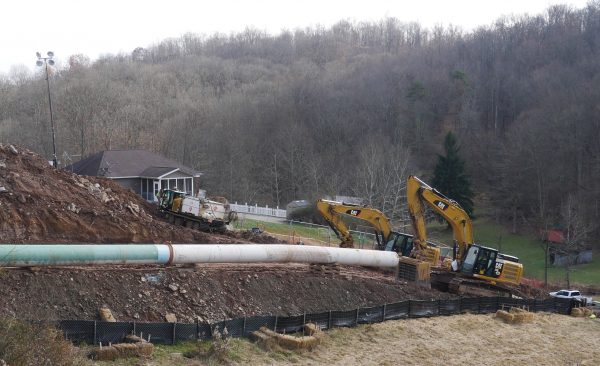
March 26 Update: Rover in Ohio: Residents near Wooster awoken by terrifying noise coming from nearby gas compressor station
See more Rover Pipeline construction photos over on flickr: here and here.
For the last couple of days, I’ve been travelling with Bill Hughes, observing some of the impacts of the Rover Pipeline construction in Tyler and Wetzel counties in West Virginia.
Almost daily since August, when the surveying started, Bill’s been monitoring this site, two miles east of Sistersville, WV. This spot is at about what Energy Transfer Partners labels mile point 28 of the 713-mile Rover Pipeline.
Bill brought me here two days in a row. Each time we stayed probably less than an hour—that was about all I could take as the diesel fumes, rock dust from the drilling and excavation, and noise levels were close to intolerable. Imagine having to endure this for weeks so close to your formerly quiet rural home! (In the shot above, notice the light fixture. Some activity goes on after dark, too.) Imagine being one of the workers constantly subjected to these pollutants!
The first day we visited, Bill spoke with one of the homeowners, who told Bill his family had no water. Even though a survey crew had clearly marked domestic water and gas lines before the excavation began, something happened and the family’s water supply was cut off. (A few weeks prior, their gas line had been cut.) Once we zoomed in on some of the photos we took during our visits, Bill speculated on what may have happened to the water line…
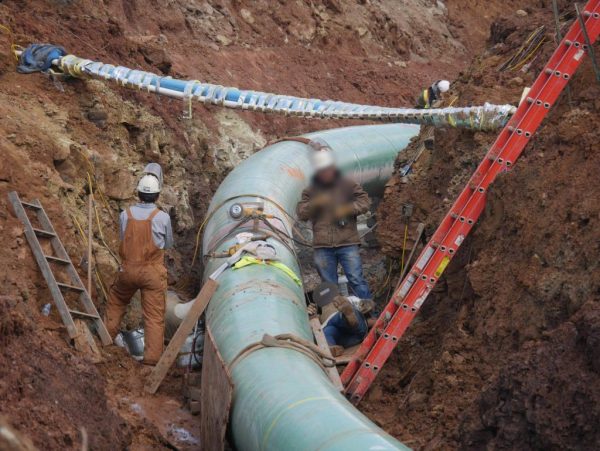
Above: Notice the smaller, darker blue pipe crossing at the top of the photo, above the fellows who are welding together two sections of the 36-inch diameter pipeline (in other areas, the Rover Pipeline is 42-inch). Lashed with pipe-wrap insulation tape to that blue pipeline is a white water line. Also attached to the blue pipe are a heat tape and an an extension cord (plugged into a stinky diesel generator). Since we could see no sign of the water line having been severed by excavation equipment (although that could be the case), Bill speculates that the blue pipe was strung across the work area to help support the water line, and the assorted heating elements—added after the family notified the construction crew that they had no water. Speculation: the intact water line may have frozen the night after it was exposed.
One area resident, who is an active military member and had been a WV State Trooper, told Bill he’s gravely concerned about his community’s safety. He says he knows the inherent dangers of firearms, having worn a sidearm for decades, but he is much more fearful of the close location of this high-pressure, high-volume, highly explosive gas pipeline (the gas will flow in the pipe at approximately 1400 PSI). The resident says he can control his firearm, but he can’t control the Rover Pipeline in his backyard, from now to forever.
The eight homes in this community are located an average of 350 feet from the pipeline. Should a malfunction occur, the incineration zone for the pipeline is a radius of approximately 1000 to 1400 feet. That is, should a blast occur, everything within about 1000 feet will be incinerated.
Bill set up this screen shot from Google Earth, with an approximation of the pipeline’s route, so that you can more readily visualize how close the pipeline is to the eight homes here:
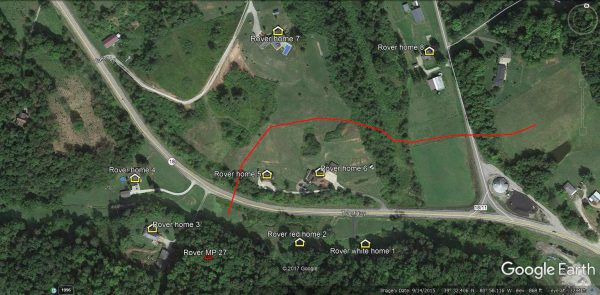
Below are some more photos from this particular area, along with a little video footage illustrating the aforementioned dust. Rover, Rover, why oh why did you come over so close to these families?!
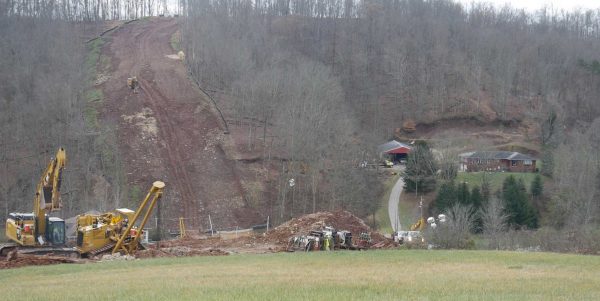
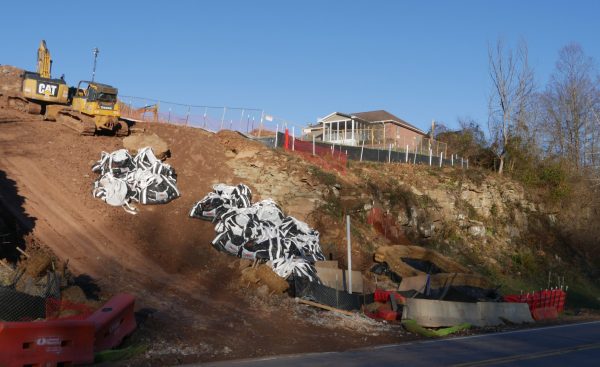
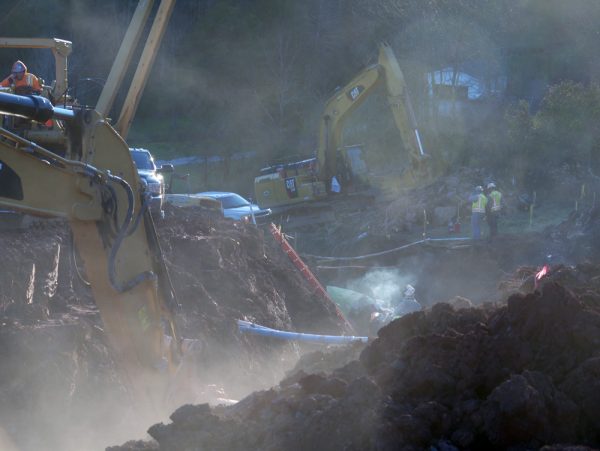
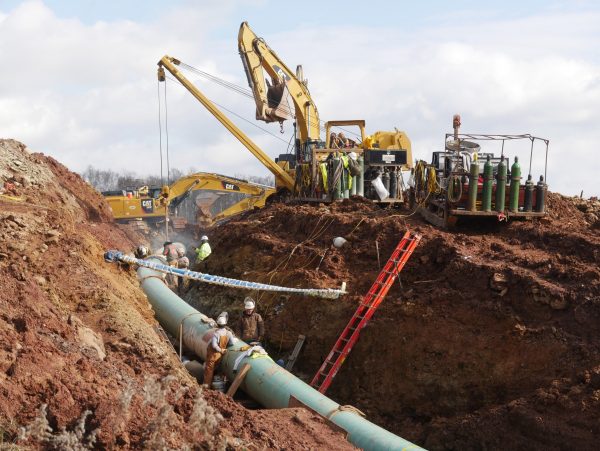
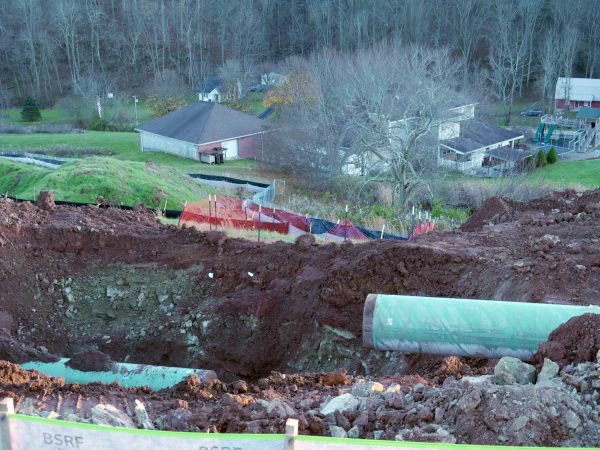
*E&E News: The East Coast’s pipeline wars: A cheat sheet:
Rover
Length: 713 miles
Route: From processing plants in Pennsylvania, West Virginia and Ohio to delivery points in Ohio and Michigan
Status: Some segments in service, others under construction; completion expected in early 2018
The $4.2 billion Rover project to move up to 3.25 billion cubic feet of gas from Mid-Atlantic shale plays is being developed by Energy Transfer Partners LP, the company behind the heavily protested Dakota Access oil pipeline.
The project had problems with drilling fluid leaks and other environmental issues in Ohio almost as soon as construction started this spring, and the state of Ohio is suing Energy Transfer Partners on charges that it violated state air and water protection laws. West Virginia regulators also briefly stopped construction on the project, and Energy Transfer Partners is operating under construction limitations from FERC.
FERC also has an ongoing investigation into whether the company used unapproved ingredients in its drilling fluid mix. In 2015, Energy Transfer Partners purchased a historic home near the pipeline route with assurances that it would be protected, but instead demolished it. FERC and Ohio state agencies negotiated a settlement for potential violation of the National Historic Preservation Act, and the company paid a portion of the agreed fine but has indicated it will not pay the balance.


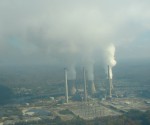

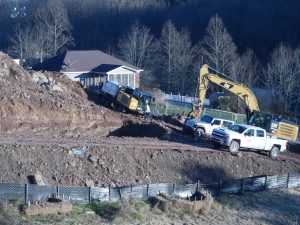







I am one of the “eight homes”. You have exaggerated the situation and vilified the workers. The rock dust does not come close to the amount wood smoke from area homes that burn for the heat. And it only takes days to bust up the stone. It’s not an ongoing issue. The light towers you mentioned are needed because it gets dark by five o’clock this time of year. Those lights are for safety! These are day workers only. And the worry of shooting the pipeline? Have you noticed how deep the pipeline is buried? Please stop using scare tactics! Instead you should mention how many jobs have been, and will be created through this expansion, how we as a country become less dependent on other countries for our needs. Your “resident source” was paid for the inconvenience he’s experienced. Yet you vilify workers for a mistake any worker, construction or homeowner, could make. The pipeline workers have been very mannered, and are hard workers. Give them some respect. Oh, and did you get the permission of the workers in these pictures to show their faces? I doubt it.
Thanks for taking time to read and comment on the post. I feel you may have misread some of what I say.
Bill and I are sorry that you feel we vilified workers. We differ with that opinion: we mentioned a concern for their health as they are subject to these conditions day in and day out. (As an aside, no doubt if you live or travel near this site, you will have noted the license plates on the worker’s vehicles—so many from out of state!) And yes, actually, we did intend to blur out any visible faces to underscore that this is not about the workers. There was one photo published where a worker’s face would be visible if someone enlarged the photo, but that error is being fixed.
Bill took time to convey to me that the pipeline construction workers are doing excellent work, regularly complying with all professional standards, in dangerous conditions and in all kind of weather on very steep hills. We feel it is truly a credit to them that they work so safety and professionally and get the job done well and in a timely manner. Many of these workers are working with subcontractors that strive to do good work. It is the parent corporations that are a big concern. In this case the parent corporation is Energy Transfer Partners, located in Texas.
If you are not concerned about safety, perhaps the impact of pipelines on property values will be of concern to you, or at least to the county commissioners.
Or perhaps you might be concerned to know that there’s most likely an overcapacity of pipelines already, but these corporations press ahead to churn out the interstate pipelines, bullying those reluctant into signing right-of-ways, threatening and using eminent domain (for private gain!) because these corporations are authorized by FERC (Federal Energy Regulatory Commission) to recoup all of their pipeline costs from us, the ratepayers… plus 14 percent!
If this kind of greed, greed that disrupts human lives and costs property owners is not a concern to you, perhaps another factor will be of concern. In this post, we did not elaborate on one main point. This 1400-foot long section of pipe near Greenwood Road and Route 18 in Tyler County, (which is the section described here) did not have to be where it is. This section of pipe could have more safely been installed on the hill above and come down the hill near the WV highway property where no one lives. Energy Transfer Partners decided on pipeline route placement. The installation contractor has no choice but to work with the given route chose by Rover, even if the route is not the best one available. This route was clearly a poor choice and now has permanently endangered residents of at least eight homes.
Thanks to FERC, Energy Transfer Partners had eminent domain for this Rover Pipeline project. The corporation knew it could take anyone’s land it that it wanted to take and Rover did take whatever land it wanted. Only a few neighbors were give some money for their lifetime danger. Once the route was chosen by Rover, the pipeline contractor then must do the best it can with what ever route is chosen by the pipeline owners.
(Landowners seem to have little or no choice. However, as a note to those who have been approached by oil and gas land agents elsewhere: don’t sign anything until you see a good lawyer. People have been cheated. You have the right to protect your home, your land, and your family’s health and safety.)
Dear commenter, please do reread the section where we refer to the one resident’s worries, as you do seem to have misread that. We said nothing about shooting at pipelines! The resident was comparing the possible danger of sidearms with the permanent and now unavoidable danger of a nearby high pressure, explosive, large-diameter gas line near many homes.
The welding operations shown here, the inspections and weld testing going on are no doubt professional. However, keep in mind that the professional welding was being done on imported pipe, made in Greece. The “Made in Greece” label is stamped inside each section of pipe; we can’t be confident that the pipe was manufactured to the high quality we could trust were the pipe manufactured in the USA. Even excellent quality pipe joint welds done on inferior grades of pipes of questionable metallurgical specifications might present a long-term danger for these eight homes. We can trust the welder here, but can we trust the foreign-made pipe? I reckon most people would feel a lot more confident with high quality pipe made in America by American (USWA) steelworkers. Some of the pipe Rover is using is made in India. Same problem.
You are right that the rock dust was only for a week or so, right there near Route 18 and only a problem for those nearby. Except of course, for the workers who may be exposed over and over to those kinds of conditions, depending on the geology of the area they are working in. And there’s the long-term exposure to those off-road diesel fumes.
Yes, the text says, “…should a blast occur, everything within about 1000 feet will be incinerated.” This was an underestimation, an attempt to err on the side of caution, if such a thing can be done when discussing blasts zones. Bill calculated the incineration zone to be more than 1500 feet. Within that range, should a blast occur, there will be major impact, scorched earth, and structural damage. The average distance of the eight homes in this area is not more than 350 feet or so.
Bill and I are both very sorry that you have to live in one of the home that appears to be at risk if there is ever a problem with the pipeline. It’s also upsetting that the value of your home may well be reduced should you ever wish to sell!
Bill worked up a chart which I am unable to post in this reply format, but the details are this: Home one is 500 feet from the pipeline, home two is 370 feet, home three is 320 feet, home four is 470 feet, home five is 90 feet, home six is 260 feet, home seven is 350 feet and home eight is 400 feet from the pipeline. Total = 2810 feet, and that means the average is 351 feet. The incineration zone reaches 1500 feet.
The concerns about the pipeline(s) do not apply to homes in this area alone. The intense buildout of pipelines West Virginia (and the nation) faces has implications for people everywhere who live above gas-bearing shale deposits. Shale gas development is turning rural West Virginia into an industrial landscape. People have lost their water and their health. In West Virginia, troubles in areas “developed” for Marcellus and Utica Shale include intense traffic problems including accidents and ruined roads; air, water and noise pollution and associated health problems from large-truck traffic, drilling and radioactive waste “disposal;” as well as the end of a rural way of life. (If you can, watch In These Hills and Hollows. If you like, we could set up a discussion and showing of this documentary—which includes the voice of neighbors in your area.)
Earthquakes are associated with fracking related activity. All the deep well bores drilled into the earth can never be closed. The amount of water used in fracking is staggering; much of the water is now removed from the water cycle. The long term impacts on the geology of our regions are at this time unknown. These pipelines too, seem to lock us into more and more of this drilling and reliance on climate crushing fossil fuel use, at the very time when we should be making an all-out push on renewable energy.
Stephanie Riddle gets it!
**high five**
I would be interested to see Ms. Vivian’s sources and their credibility she is referencing, especially since this article (and likely this site) only has three comments.
Also, what was Ms. Vivian’s fossil fuel carbon footprint driving to this location to stay less than an hour to draft this enviro-fascist article?
This will impact their lives forever, or until one of those 8 homes decides to move. The value of their home will drop. God forbid there is a blast bc all eight homes will be incinerated and IF anyone in those homes survives, you can rest assured they will not be properly reimbursed. Look up Mayflower oil spill. All of this so these corporations can EXPORT this gas.
The pipelines will only invite fracking wells, which are very disruptive to any standards of our current lives. This has caused fracking to have been banned by several states. In December of 2012, a 30″ pipeline exploded, smaller than the Rover pipeline, at Sissonville, WV, and melted four lanes of I-77, flattened four homes, and damaged five more homes. Our rural areas being turned into industrial sites is ruining our beautiful scenery and may be affecting our tourism industry. I believe that our reliance on fossil fuels is very unwise, and that sustainable energy is the cleanest and most readily available sources that God has given to humanity. I am a lifelong resident of West Virginia, and my family has lived in the Appalachian region for four generations, that I can easily recall.
Vivian, thank you for this report. Our county in VA is in the path of the proposed Atlantic Coast Pipeline, a 42 inch, high pressure fracked gas pipeline. Your report is the stark reality of the construction mayhem of these pipelines. The company responsible for ACP has a record of disregard for the law and usually gets what they want because they are rich, powerful and own our politicians. We remain in constant fear of the destruction, loss of property values, water quality and quantity damage, and disrespect this project will bring to our communities. Please remain steadfast in your reporting.